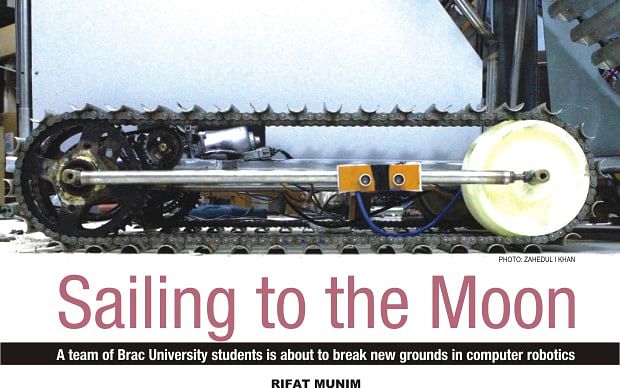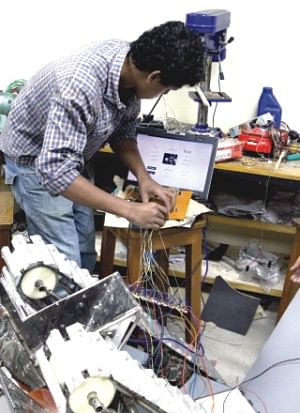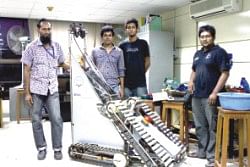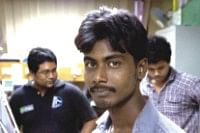| Home - Back Issues - The Team - Contact Us |
 |
| Volume 10 |Issue 20 | May 27, 2011 | |
|
|
Achievement
Poet Jibanananda Das, lying on his back with his gaze fixed on the glowing or the falling stars and outpacing the formidable planets and stars of the skies, showed us in his poems how to leap outside the spheres of this earth and be a part of the whole universe. It was with an identical desire of reaching the stars that a group of students of the engineering school at Brac University started to work on a robotics project. Only they had to begin the journey by setting sails to the moon. While the poet made the communication with his unbound imagination, these young talents compounded with it a bit of scientific observation and a lot of experimentation. The team, comprising four students and a teacher, is all set to take part in an international Lunabotics Mining Competition with their ingeniously built robot in what is a major breakthrough in the country's computer robotics. The robot has been named Chondrobot. A compound of Bengali and English, the name is highly suggestive of a boat that will sail to the moon. In a country where a large part of the students make a dent in student politics marked by strife, violence and money-making, such news comes as a model epitomising how students can break new grounds and make a mark in the global arena of excellence.
The competition, organised by (NASA), is a national event which invites models and designs for lunar robots from across different states of the US. This is the first time the competition is taking an international shape with as much as 46 countries participating. The event is intended to generate new ideas and solutions for lunar excavations from all over the world. The award-winning designs will be selected for future NASA expeditions. Our story, the making of the Chondrobot, traces back to last year when Dr Md Khalilur Rahman, assistant professor at the department of Computer Science and Engineering, started a course titled Computer Robotics for senior undergraduate students. After the course ended, Shibli Imtiaz Ahmed, one of his CSE students, appeared and told him out of the blue that he had applied for the NASA competition. Rahman, a little provoked at first considering the challenges, decided to sit with two senior teachers and several other students. “I was a little angry in the beginning because Shibli did not consult with me before applying. We don't have any previous experience of this. Nor do we have any materials or machinery. So how'd we ever make it there?” However, the senior teachers Dr Mohammed Belal Bhuiyan and Dr Md Mosaddeque were very upbeat about the project and encouraged all to move ahead with the plan. After all, they said, it was for the first time the Bangladeshi students were going to lay their hands on something like this. Thus shored up, Khalilur Rahman chose Shibli as the team leader and three other students from the Department of Electrical Engineering as team members. The team members are Junayed, Mahmud Hasan Ayon and Rajin; they all are now in the fourth year of the department. When the team was all set in October 2010, they hit upon the idea by sketching a design of the robot. They sent the design to the NASA authority which took some time to respond. The long silence was a big disappointment for the team. Meanwhile, Shibli completed the 3-D CAD design (AutoCAD animation), and sent it again. Surprisingly, this time the response came almost immediately. “We are not sure if it is for the animated design, but within three hours of sending it, they replied confirming that we were selected,” recollects Rahman, who is also the faculty adviser of the project Then began the real work, which brought about several challenges – procuring the metallic and electrical materials, and also the necessary software and other related things. First of all, they had to bear in mind a number of prerequisites that were set by NASA. The robot will have to collect and deposit a minimum of 10 kg of lunar simulant (simulated moon dirt) within 15 minutes. It has to go by the weight and size limitations: the weight cannot be more than 80 kg while the height cannot exceed 2 metres, the width .75 metre, and depth 1.5 metres. Moreover, it will have to be operated from a remote control centre and the only way to view the robot's performance in a given environment is through an on-board camera. It will have to unload the stimulant into a collection bin that is one metre above the soil.
“Although all these complex preconditions posed several challenges for us, we never gave up. We had to spend a lot of time for this. Sometimes we had to rebuild a part several times, but the team spirit was so great that finally we got it through,” says Rahman. The speciality of the Chondrobot lies in its two wheels that are made of steel pipes cut in halves, which are then fixed all around a motorcycle chain. When the wheels roll, the cut steel pipes automatically will scoop soil from the ground and put it in a collector. Several car wipers' motors have been used to drive the robot into motion. There are two other sources of power: one is the computer and the other the controller's circuit or micro-controller. But the batteries used for power generation are solar cell batteries, not liquid ones as mandated by NASA.The wi-fi connected computer will be put inside the structure. To help pass commands from the control room to the robot, the team has also developed software. Junayed, who has worked extensively on the controller's circuit, explains how the whole thing will work. “The control room will be 60 metres from the ground. From the control room as we will command through the software with the joystick or computer key board, it will be received by the computer put inside the Chondrobot. Thus the commands will be passed and received and the robot will do or move as commanded.” Building up the whole robot was a lot more complex than this. There were several other metallic and electric parts in the structure. Piecing together all those separate parts by wielding and with electric devices was indeed a hectic task. Apart from the above mentioned parts and materials, there were also steel sheets, steel pipes, cables of motorcycle brake, footboard of a bus, aluminium pipes, bicycle parts and many more. The first challenge was to manage all these parts and then to understand what specific material would fit for their purpose. Since they had no prior knowledge or experience, sometimes they had to rebuild one part several times. “Just think of the wheel. First, we used the rickshaw wheels; but it got twisted while wielding. Then we went for the motorcycle chain and it did not twist but became heavier. Then there were the pipes. We first completed the model wheel using the aluminium pipes, but it didn't work the way we expected it to, so we used steel pipes instead. We had to revise the model wheel at least six times,” explains Ayon. Ayon, along with Rajin, has worked tirelessly on building the metallic structure and fixing the electrical devices. Their experience is another interesting part of the project. “Constructing such a structure out of steel sheets, motors, and aluminium pipes is a typical work requiring extensive knowledge in mechanical engineering. However, none of us are students of mechanical engineering. Still, we took the challenge and finally made it there,” says Rajin.
Asked about the most exciting memories or experiences while working for this, all of the team members, except Shibli who had already left for the US for collecting some materials that are not available in Bangladesh, voice that the unfaltering team spirit made the work always exciting for them, and they enjoyed every bit of it. “Even when we had to move hours after hours in Dholaikhal or Noabganj to collect unused car parts, motors and other materials, we kind of enjoyed it,” recollects Ayon. “Still, the most enjoyable times were when we stayed up the whole night at Monir Bhai's workshop in Mahakhali to complete the work. Although we worked for at least 12 hours a day throughout a week in this way, we never felt exhausted,” remembers Rajin. Having collected the materials, when the team went to Dholaikhal for wielding facilities, everyone asked them to leave the design and materials with them to do the work later at their convenience and in their way. Even so, they charged an unreasonable amount of money as fee. Right then, Monir Hossain, who has a wielding workshop in Mahakhali, came forward and offered to help. “If Monir was not there, I don't know how we'd ever wind it up,” says Khalilur Rahman. “Without Monir Bhai's help, this robot would not have been built. Sometimes, one single part required wielding so many times, and whenever we asked him to do this, he was there for us,” admits Rajin. However, the story turns sad on the other side of the coin. While all of the team members were given the US visa, only Junayed was refused, apparently for no reason. The team has flown to Florida, US, where the competition will be held on May 21. As of writing this report (May 22, 2011), Junayed has not yet been given a visa. Unfortunately enough, without Junayed who built and supervised the control circuit, the team's performance will be badly affected and the team spirit will be affected. “Junayed's role in the project has been so pivotal that I cannot think of going there without him. We have been contacting the American embassy repeatedly through emails. They have not provided us with any good reason yet,” laments Rahman. Contacted, the Dhaka office of the American embassy refused to say anything in this regard. The exact date of the competition has not yet been announced. Yet the event, Rahman has predicted, may be held towards the end of this month. A number of teams from different countries will take part in the programme, but only one or two teams will get the prize. In this regard, we must keep in mind that getting selected for the competition was in itself recognition of what our young scientists can do. The opportunity to present themselves and share their views with internationally acclaimed scientists should shore up their confidence in continuing their insatiable thirst for newer inventions. Finally, kudos to the group that has enkindled in all potential scientists of the country, the passion for surpassing the moon's axis and reaching the unexplored stars like Jibanananda Das had.
Copyright
(R) thedailystar.net 2011 |
||||||



